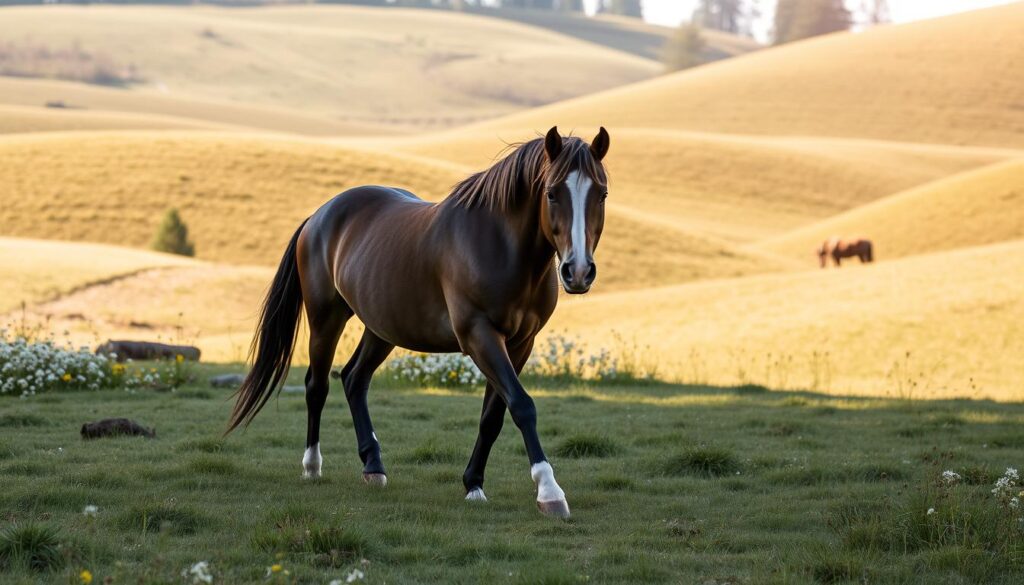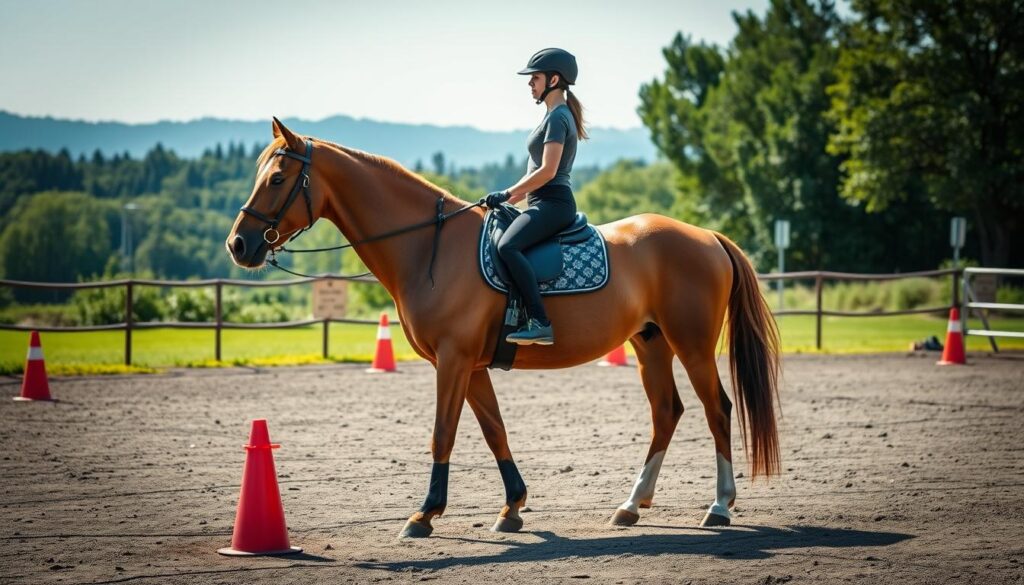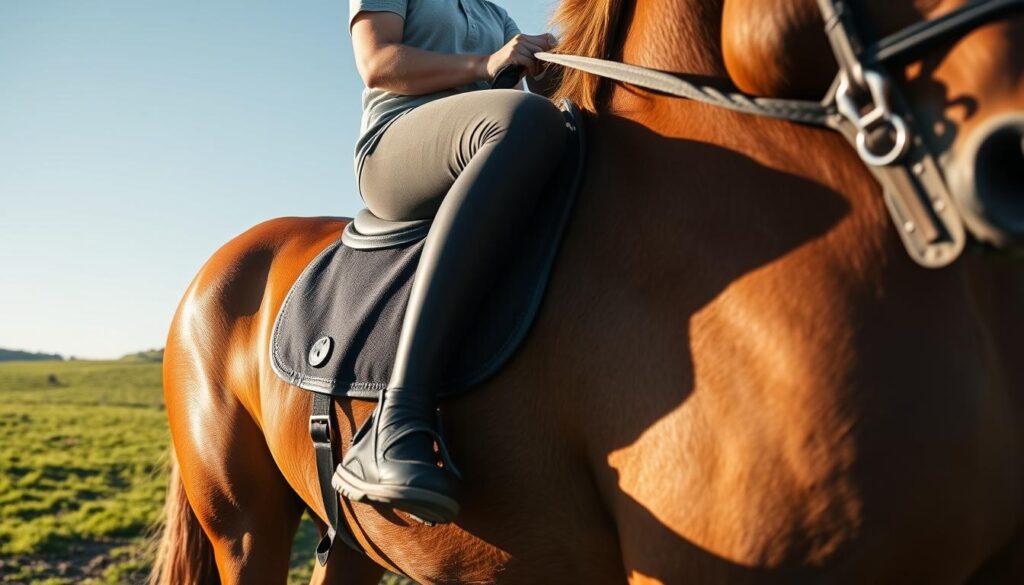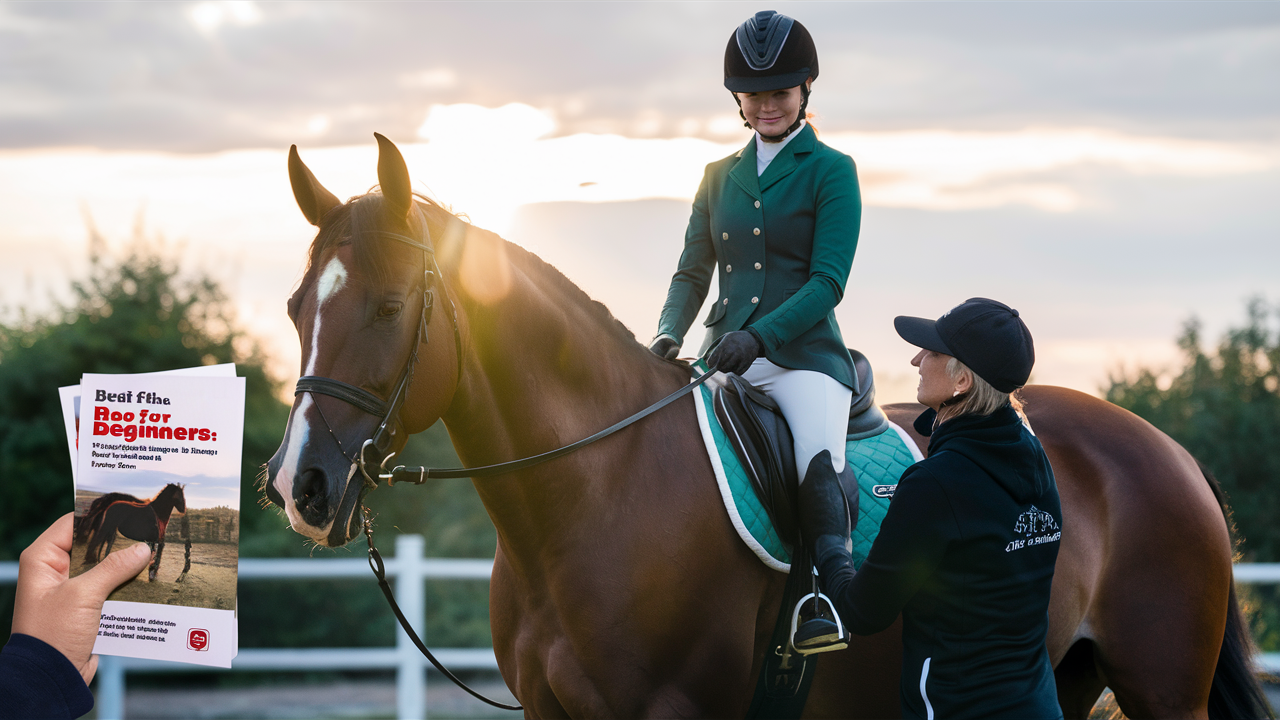Learning to ride a horse safely is key for new riders. With the right tips and safety guide, you can have fun and stay safe. This article offers valuable insights and tips for safe horse riding.
To start horseback riding, you need to know the basics of safety. This includes understanding horse behavior, wearing the right gear, and learning how to ride. By following these tips, you can become a confident rider. Horseback riding is a skill that takes time and practice, but with the right guidance, you can enjoy it safely.
Key Takeaways
- Learn the basics of horse riding safety to ensure a fun and safe experience
- Understand horse behavior and body language to build trust with your horse
- Invest in proper safety gear, including a helmet and riding boots
- Practice proper riding techniques, including mounting and dismounting
- Follow expert tips and guidelines to become a confident and skilled rider
- Always prioritize horseback riding safety and take necessary precautions
- Continuously learn and improve your horse riding skills with an equestrian safety guide
Understanding Basic Horse Psychology
Building a strong bond with your horse is key for a safe and fun ride. It’s all about knowing horse behavior and using the right horse riding techniques. By understanding and meeting your horse’s emotions and needs, you can build trust and a positive bond.
Safe horsemanship means knowing horse behavior and body language well. You need to read signs like ear position and tail swishing to avoid dangers. With this knowledge and the right horse riding techniques, you and your horse can have a safe and fun time together.
To create a strong bond with your horse, you must understand its behavior and communicate well. Use positive methods like rewards and praise to encourage good behavior. This way, you lay a solid foundation for a safe and enjoyable ride.
Some important things to know about horse behavior include:
- Equine vision and perception
- Horse memory and learning patterns
- Gregarious nature and social behavior
By grasping these points and using effective horse riding techniques, you can ensure a safe and enjoyable experience for both you and your horse.
Essential Safety Gear for Horse Riding
Wearing the right gear is key for a safe and fun ride. Proper horse riding gear includes a helmet, riding boots, and gloves. These protect you from injury if you fall. Wearing reflective clothes also helps you be seen better, especially at night.
For horse riding safety rules, some gear is more important than others. Stirrups and reins help you control the horse and stay balanced. A good saddle and bridle are also vital for a safe and comfy ride. By using the right gear and following safety rules, you can avoid injuries and have a great time.
- A helmet that meets safety standards
- Riding boots with a low heel and slip-resistant soles
- Gloves to provide grip and protection for your hands
- Reflective clothing to increase visibility
- A well-fitting saddle and bridle
Investing in the right gear and following safety rules makes riding safe and fun. Always wear your gear and follow safety tips. This way, you can enjoy a safe and rewarding ride.
Preparing to Mount Your Horse
Before you get on your horse, it’s key to follow safety rules and beginner instructions. Approach your horse calmly and speak softly to not scare them. Always wear the right gear, like a helmet and boots with a low heel.
Do safety checks before you get on. Make sure the girth, stirrups, and reins are right. A good saddle and stirrups make for a safe and comfy ride.
Pre-Mounting Safety Checks
- Check the girth to ensure it’s snug but not too tight
- Adjust the stirrups to a comfortable length
- Verify the reins are properly secured to the bridle
Mounting right is important for beginners. Always get on from the left side, facing the horse’s left shoulder. Use a block or stool if needed, and don’t pull on the reins or saddle horn.
Proper Mounting Technique
After you’re on, adjust your seat for comfort and safety. Keep your feet in the stirrups, back straight, and hands on the reins. Always follow safety rules and beginner instructions for a safe and fun ride.
How to Ride a Horse Safely: Step-by-Step Guide
To ride a horse safely, you need to follow a step-by-step guide. How to Ride a Horse Safely is key to enjoying horse riding. With the right horseback riding tips, you can have a safe and fun time.
Here are some important steps to follow:
- Start by walking your horse, getting a feel for its movement and rhythm.
- As you become more comfortable, you can progress to trotting, remembering to maintain balance and control.
- Turning is also an essential aspect of horse riding, and with practice, you can master the art of smooth, safe turns.
Remember, horseback riding tips are not just about the technical aspects of riding. They also help you understand your horse’s behavior and body language. By following these tips and practicing regularly, you can become a confident and safe horse rider.
Always keep in mind that How to Ride a Horse Safely is a continuous learning process. With patience, practice, and the right horseback riding tips, you can enjoy a safe and rewarding horse riding experience.
Mastering Basic Riding Positions
To become a skilled horse rider, mastering basic riding positions is key. These horse riding techniques are crucial for safe horsemanship practices. They help you balance and control while riding, making it easier to communicate with your horse. By practicing these positions, you’ll ride with confidence and precision.
There are several key positions to focus on, including:
- Two-point position: This position involves sitting lightly in the saddle with your weight evenly distributed between both legs.
- Three-point position: In this position, your weight is distributed between both legs and the saddle, providing additional support and balance.
- Full seat position: This position involves sitting deeply in the saddle with your weight evenly distributed, providing maximum control and stability.
Mastering these basic riding positions gives you a strong foundation in horse riding techniques and safe horsemanship practices. This lets you ride with confidence and precision. Always remember to prioritize your safety and your horse’s safety by following safe horsemanship practices and getting advice from experienced instructors.
With practice and dedication, you’ll become proficient in these positions. This will let you move on to more advanced horse riding techniques and enjoy a rewarding riding experience.
Understanding Horse Walking Gaits
Knowing how horses behave is key for a safe ride. Riders must understand their horse’s gait and any changes. There are three main walking gaits: walk, trot, and canter. Each has its own traits, helping riders spot potential dangers.
It’s vital to watch your horse’s body language and behavior while riding. Small changes in their gait can mean they’re not feeling well or are too excited. This lets riders take steps to keep the ride safe and fun. For example, a trotting horse might need more control than a walking one.
Important things to think about when learning about horse gaits include:
- Gait speed and rhythm
- Horse behavior and body language
- Rider balance and control
By keeping these in mind, riders can better handle changes in their horse’s gait. This makes for a safer and more enjoyable ride.

Understanding horse walking gaits is a big part of riding safety. By noticing and acting on changes in their horse’s gait, riders can avoid accidents. This ensures a safe and fun ride for everyone.
Proper Rein Control and Hand Positions
Learning to control the reins and hold your hands correctly is key to talking to your horse and staying in control. This is a basic part of horse riding techniques and safe horsemanship practices. You need to know the different ways to hold the reins and use them right.
Steering your horse safely and well is important. You do this by making small moves with the reins to guide your horse. Adding clear body language helps you and your horse work together well, based on trust and clear communication.
- Understanding the basics of rein control and hand positions
- Mastering different types of rein holds, such as the direct rein and indirect rein
- Developing clear and consistent communication with your horse through the reins and body language
By working on these skills and following safe horsemanship practices, riders can make their horse riding better. They can also strengthen their bond with their horse.
Essential Commands and Cues
Learning essential commands and cues is key to horse riding safety. As a beginner, knowing how to communicate with your horse is vital. You’ll use verbal cues, body language, and rein aids to tell your horse what to do.
Some important commands to learn are starting, stopping, and turning your horse. Clear and consistent cues help build trust and keep you safe. For instance, a gentle rein aid can tell your horse to turn. You can also use your body weight to guide them.
Here are some essential cues to get you started:
- Verbal cues: use a clear and calm voice to give commands, such as “walk” or “trot”
- Body language: use your body position and weight to guide your horse, such as leaning forward to signal a transition
- Rein aids: use gentle and consistent rein aids to communicate with your horse, such as a soft pull on the reins to signal a stop
Mastering these commands and cues will make you a confident and safe rider. Always follow safety rules and practice to enjoy a safe ride.
Common Beginner Mistakes to Avoid
As a beginner horse rider, knowing common mistakes is key. These mistakes can put you and your horse at risk. By following good horseback riding tips and an equestrian safety guide, you can avoid accidents and enjoy riding more.
Maintaining the right position and posture is crucial. It helps you stay balanced and communicate better with your horse.
Some common errors include leaning too far forward or backward. This can upset your balance and increase the chance of falling. It’s also important to keep your heels down and sit evenly in the saddle. These tips can help you ride better and stay safe.

Communication mistakes can also harm your riding experience. Not talking clearly and consistently with your horse can cause confusion and frustration. This can make riding unsafe. By following a safety guide and practicing good communication, you can connect better with your horse and ride safer.
Position and Posture Errors
- Leaning forward or backward
- Failing to keep heels down
- Uneven weight distribution in the saddle
Communication Mistakes
- Failing to communicate clearly and consistently
- Using inconsistent or confusing commands
- Not paying attention to horse behavior signals
Knowing these mistakes and how to avoid them can make you a better rider. Always follow good horseback riding tips and an equestrian safety guide. This way, you can have a safe and fun riding experience.
Building Confidence in the Saddle
To become a skilled horse rider, building confidence is key. This can be done by practicing horse riding techniques and following safe horsemanship practices. Setting goals and tracking progress helps too. It builds a positive mindset and helps overcome fear.
Here are some tips for boosting your confidence:
- Start with short rides and gradually increase the time.
- Practice in a controlled area, like an arena.
- Work on your riding skills, such as balance and posture.
Working with a qualified instructor is also helpful. They can give you personalized feedback and guidance. This helps you overcome any challenges you face.
By following these tips and practicing often, you can gain confidence in the saddle. Always remember to prioritize safe horsemanship practices. If you’re unsure about anything, ask a qualified instructor for help.
As you get better, you’ll feel more comfortable and confident. This lets you try more advanced horse riding techniques. You can explore new things like trail riding or competing in horse shows.
Understanding Arena Safety and Etiquette
Knowing the rules of arena safety and etiquette is key for a safe and respectful ride. As a beginner, following instructions is crucial for a good experience. We’ll talk about right of way, spacing, and emergency plans.
It’s important to be aware of your surroundings in the arena. Follow basic safety rules to avoid accidents. This includes watching out for others, keeping a safe distance, and not making sudden moves.
Right of Way Rules
Following right of way rules is vital in the arena. It helps avoid collisions and keeps everyone safe. This means yielding to others, knowing where you are, and talking to other riders.
Proper Spacing Between Horses
Keeping the right distance between horses is essential. It keeps the ride safe and respectful. This means not crowding others and respecting your horse’s space.
By following safety rules and instructions, you can have a safe and enjoyable ride. Always be aware of your surroundings. Follow right of way rules and keep the right distance from other horses. With practice, you’ll become a confident rider.
Developing a Strong Leg Position
A strong leg position is key in horse riding. It helps riders stay balanced and in control. This is important for safe riding, as it lets riders talk to their horses and handle different situations well.
To get a strong leg position, riders need to strengthen their core and leg muscles. They can do this with exercises like squats, lunges, and leg presses. Also, they should practice proper leg positioning while riding. This means keeping heels down and toes up, with legs relaxed and balanced in the stirrups.
Here are some tips for a strong leg position:
- Keep your feet right, with the balls of your feet on the stirrups and heels down
- Relax your legs and avoid tension, which can mess with the horse’s movement
- Use your core muscles to keep balance and stability

By following these tips and practicing safe riding, riders can improve their leg position. This makes their riding better and helps them talk to their horses more effectively.
Managing Unexpected Situations
As a horseback rider, being ready for surprises is key. Horseback riding tips and an equestrian safety guide are very helpful. They teach you how to handle sudden scares, horse resistance, and how to get off quickly if needed.
Staying calm and talking clearly to your horse is very important. Here are some important things to remember:
- Know when your horse is spooked, like when they move suddenly or change how they stand
- Use clear and consistent communication to calm your horse and take back control
- Be ready to get off safely if something goes wrong
By following these horseback riding tips and keeping an eye on your surroundings, you can lower the chance of accidents. Always put your safety and your horse’s first. If you’re not sure about something, ask an experienced instructor or equestrian safety guide for help.
Mastering the Art of Horseback Riding
To become a skilled horseback rider, you need to learn horse riding techniques and follow safe horsemanship practices. This means spending time on balance, talking to your horse, and getting better at riding. Setting goals and tracking your progress keeps you motivated and focused.
Some key areas to focus on include:
- Developing a strong seat and balance in the saddle
- Refining your communication with your horse through clear and consistent cues
- Practicing various horse riding techniques, such as walking, trotting, and cantering
Getting help from experienced instructors is very helpful. They can improve your riding skills and teach you safe horsemanship practices. A good instructor gives you feedback and helps you overcome challenges.
Mastering horseback riding takes time, patience, and dedication. Stay committed to your goals and keep improving. With practice and persistence, you’ll become a confident and skilled rider. Enjoying horseback riding for life is possible with hard work and passion.
Taking Your Riding Journey Forward
Now that you know the basics of horseback riding, it’s time to move forward. Keep learning and practicing to become more confident and skilled. Look for experienced instructors to help you improve your riding.
Joining horseback riding clubs or equestrian groups is a great idea. You’ll meet others who love riding and can join in fun events and competitions.
Always remember the safety rules you’ve learned. Stay alert and follow safety protocols. With hard work and a sense of adventure, you can keep getting better at horse riding.
FAQ
Q: What are the essential safety gear requirements for horse riding?
A: Safety is key when riding horses. You need a helmet, riding boots with a heel, and gloves. Reflective clothes and safety gear like stirrups and reins are also a must for a safe ride.
Q: How do I properly mount and adjust my position in the saddle?
A: Always check your horse before mounting. Approach from the left, stand by the shoulder, and use the stirrup to mount. Adjust your seat by balancing your weight and keeping your heels down.
Q: What are the essential commands and cues for communicating with my horse?
A: Knowing basic commands is vital for talking to your horse. Use “walk,” “trot,” and “whoa” to control speed. Also, use body language and reins to steer and stop.
Q: How do I handle unexpected situations, like a spooking or resistant horse?
A: Stay calm in unexpected situations. If your horse spooks, use gentle reins and keep your weight centered. Avoid sudden movements. Know how to safely get off in emergencies.
Q: What are some common beginner mistakes to avoid when riding a horse?
A: Avoid mistakes like bad position and unclear communication. Keep your alignment right, use clear cues, and always follow safety rules. This ensures a safe and fun ride.
Q: How can I build confidence and improve my riding skills over time?
A: Building confidence and skills takes time and practice. Set goals, get advice from experts, and keep practicing. Focus on a strong leg position and understanding horse behavior to feel more confident.
Q: What are the key safety considerations when riding in an arena?
A: Arena riding requires following rules and keeping distance. Communicate with others, stay alert, and be ready for surprises. This keeps everyone safe.

